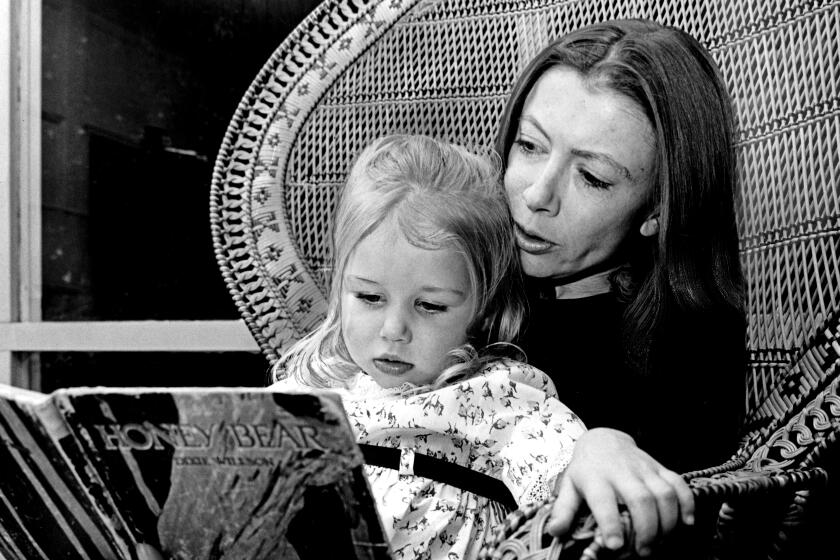Widows at the Wheel : THE WIDOWS’ ADVENTURES <i> by Charles Dickinson</i> (<i> William Morrow: $18.95; 388 pp.) </i>
- Share via
Beauty, let’s face it, is there or it’s not, but adventure is in the eye of the beholder. Nancy Mairs, a poet and essayist whose multiple sclerosis makes it uncertain on any given day that she will travel far from her bed, wrote in “Plaintext”: “I have a low adventure threshold. . . . Everything that crosses it may be an adventure, and thus (I) may be inundated and swept away by the events of a life that seems to others as still as a stagnant pond. Think about a drop of water from that pond under a microscope, however: the adventurous life.”
The elderly protagonists of Charles Dickinson’s third novel, “The Widows’ Adventures,” are likewise swept along by daily events and non-events in their Chicago suburb. Ina and her sister, Helene, have lived out their 70-plus years in the space of a few city blocks, in relative contentment, but now as the neighborhood goes to seed they’re held hostage to an unsympathetic decade. Dangerous-looking boys cut through their yards on the way to the river to cache beer; a fat burglar gets stuck trying to enter Ina’s house through the milk-box. For Helene, who is constrained by diabetes, getting to the grocery store and back in one piece is a matter of high drama.
But Ina lusts for more. She talks Helene into making a pilgrimage across the country to visit Ina’s children in California. They will go by car. This is no stagnant-pond adventure; Ina can’t drive, and Helene, who finally consents to do so, is stone-blind.
The magic Dickinson works in this painful, hilarious adventure story is twofold: First, he gives heart and life to characters whom the rest of the world would probably not notice, were they to stand for half a day or so on a street corner in Chicago or even Des Moines. From the outside they’re as invisible as the microbes in pond water, but on the inside they glow with passions, bright blue and dangerous, that jump back and forth between them like arcing electricity.
The sisters miss being energetic and pretty enough to flirt, and they miss being married. Ina, in particular, misses sex. Helene has locked away secrets of an abusive marriage that even her sister doesn’t suspect. Ina steadily drinks beer and wonders at the love of her husband, who never asked her to stop. The widows speak to each other in the caustic, funny shorthand that’s unique to siblings and very old friends.
Dickinson’s second miracle is that he makes their journey not only captivating but entirely plausible. Ina gives careful directions, and Helene is a pro at the wheel, but there’s more to the credibility formula than that. The novelist’s principal task is to make us throw aside our dust mops or squash racquets or what have you and sit rapt for several hours while we stake our hearts on a lie. Ursula K. Le Guin has pointed out that while fiction writers in their braver moments do desire the truth, they go about telling it in a peculiar and devious way, “inventing persons, places, and events which never did and never will exist . . . and then when they are done writing down this pack of lies, they say, There! That’s the truth!”
And if it works, we believe. It’s not a matter of finding stories that simulate truth (for what--I recently asked a roomful of writing students, as I waved an article about a man who piloted a plane 2,000 miles while unconscious, then crashed into the sea, then swam to safety--what could be more implausible than a true story?). The trick is to construct a story readers will want to believe, with all their hearts, and to play it out in a world so detailed and appealing that they’re prepared to pack their bags and move in. When Ina and Helene set out at 2 a.m. for California, at the speed of 12 m.p.h., I was already in the back seat.
Their trip is much more than an adventure about stop signs and avoiding head-on collisions, though these perils keep the narrative lively. The scene in which they talk their way out of a citation, after a minor accident, is somehow reminiscent of Gracie Allen, George Burns, and Cheech and Chong.
But the real journey is quieter than this. During the long night hours on the road (they eventually risk a breathtaking 40 m.p.h.) the sisters’ conversations reveal the complex interdependencies that grow out of a lifetime of love. Life is ponderously loaded with both good luck and bad, and pain can accumulate astonishingly if you live long enough, but both these women are still hell-bent on seeing what will happen tomorrow. While their children advise, ignore, and murderously irritate, Ina and Helene want nothing more than to take their lives in their own hands. Alone, they can’t quite manage, but as a team they are capable of greatness.
“The Widows’ Adventures” is that most wonderful, and increasingly rare, sort of novel written by an author who loves his characters beyond measure. The result is compelling. Gabriel Garcia Marquez once made me believe that a beautiful child could rise into the sky on a freshly laundered sheet, and now Charles Dickinson has convinced me that a blind woman can steer a Pontiac Omega across the United States. And that I’d better throw down my dust mop and go along, because it’s going to be worth the trip.
More to Read
Sign up for our Book Club newsletter
Get the latest news, events and more from the Los Angeles Times Book Club, and help us get L.A. reading and talking.
You may occasionally receive promotional content from the Los Angeles Times.








